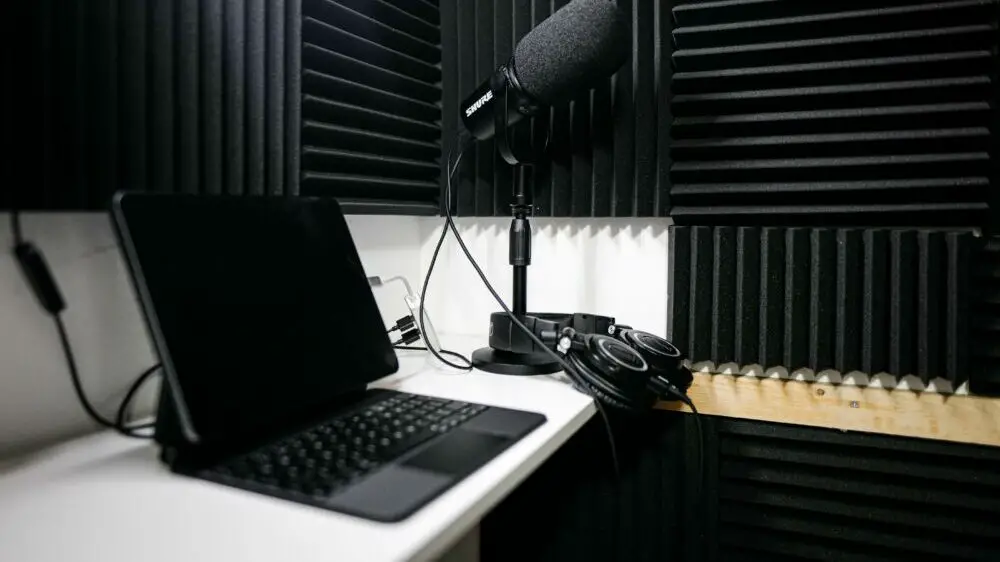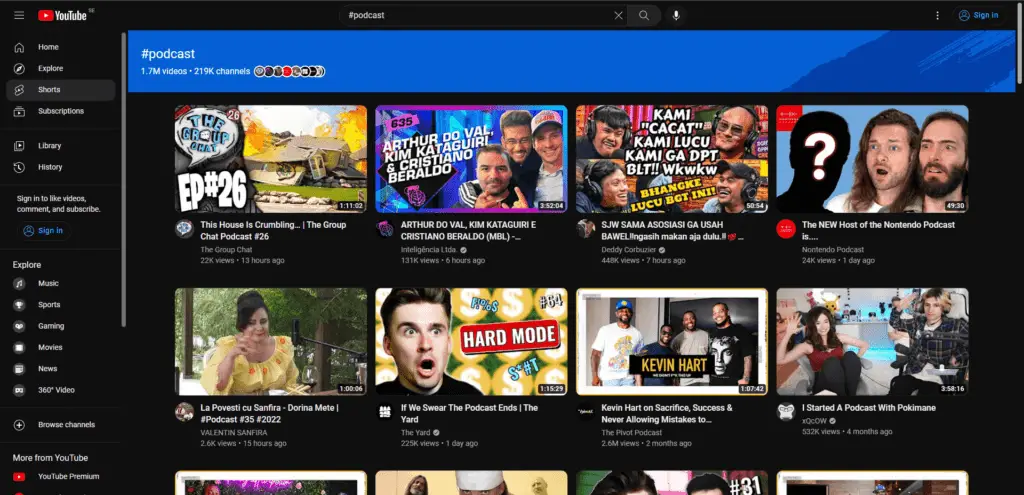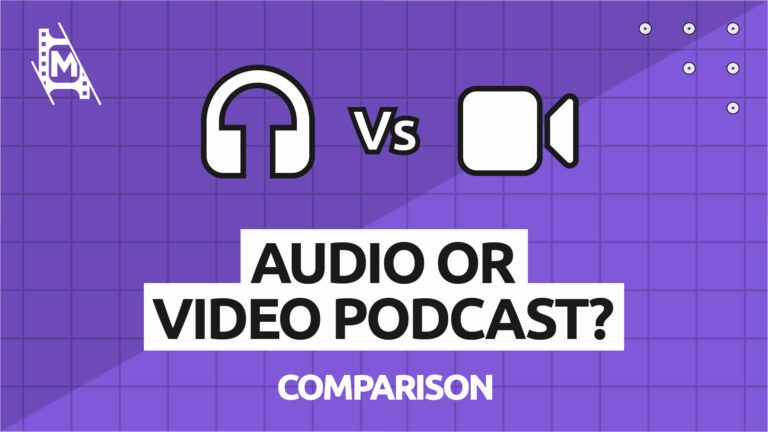When starting a podcast, you will have to make many choices related to production. One such question is whether you should do a simple audio podcast vs. including video.
In this article, we will compare the audio vs. video podcast format so you can decide which one is the best for you!
So Audio or Video in Your Podcast?
The quick answer; In an ideal world where you have an unlimited budget and lots of contacts, both of course! But video requires a lot of additional gear, investment, and time. You also limit yourself geographically to how many and what types of guests you can host.
The good news is that you won’t need video for your podcast to succeed.
Today people consume a lot of content by listening. Podcasts, audiobooks, and interviews can be listened to while commuting, working out, or doing home chores. Even longer YouTube videos are commonly played on a separate tab while the viewer does something else. This is why in many cases, video is pretty redundant. You do not need it to start a podcast by any means.

So What is a Podcast Anyways?
With video being everywhere, there might be some confusion about what a podcast even is anymore.
While there is no exact definition, a podcast should at least have an RSS feed. Even more importantly, the primary content should be audio-centered. This means that you do not have to watch something on a screen to understand some of the content.
It is the case that many YouTube shows that call themselves “podcasts” really fail with the latter. Even many big shows like “H3H3” are guilty of this when the hosts react to a video or image listeners cannot see.
This is where an audio-only podcast is advantageous. Many seek out audio-only content where they don’t have to be glued to a screen because it is much easier to consume.
Now, video in a podcast is not at all bad, of course. You should use it where it fits with your content, audience, and production abilities. This is why we will look at each format’s advantages and when it should be used in the section below.
Arguments for Audio Podcasting
As stated above, there are many limitations to doing a video podcast that you do not have with an audio format. Here are the main advantages!
Not Everyone Wants to Be In Front of the Camera
Let’s first talk about potential guests for your podcast since they are crucial in many formats.
It is no secret that not everyone wants to be in front of the camera. And many guests for your podcast might have an easier time just doing audio. Some might even decline being featured on video podcasts altogether.
This might not apply if you plan to feature celebrities that are already comfortable with having cameras pointed at them. But for most people, that is not the case.
Therefore, a video format limits the number of potential guests you can host on your show. It’s generally easier to convince people to be in front of a mic rather than a camera.
Something to consider if you have a guest-related format.
International Guests
Another factor is the geographical limitations of a video podcast. A guest or cohost must be in the same studio.
On the other hand, an audio-only podcast allows you to feature a guest or cohost anywhere in the world using Zoom, Teams, or any other online calling application.
Now you could include webcam video in your podcast. But audio is generally more consistent quality-wise, so you don’t risk an episode being canceled or laggy just because of a bad connection.
Being Able to Edit Out Mistakes
Everyone slips up sometimes.
This is why on YouTube, you will often notice creators doing jump cuts in their videos. These minor edits are usually not a big deal, but you won’t be able to edit out whole sections without the video feeling a bit off.
This is not the case with audio podcasts, as you can make seamless edits where you slip up or even remove whole sections that feel redundant using free tools like ‘Audacity.’ Audio will be a lot easier and quicker to manage than having to edit out mistakes from a video.
Production Value
You can get clear, crisp audio with relatively low investment and DIY setups. Your production value will probably feel close to any other podcast on the platform, whether produced for $500 or $10 000.

But throwing video into the mix will add a considerable level of complexity. You will have to set up a visually appealing set, lighting (often with expensive equipment), and get a proper camera with good video quality.
The post-production process also requires a lot of storage (especially for 4K video), so you would have to invest in SD cards and hard drives. Editing, grading and exporting also take considerably more time.
Doing all of this and doing it well requires more experience and investment. Even so, you probably won’t be able to match the production value of big podcasts with huge budgets behind them.
Listener Experience
We have talked a bit about the producer side of the argument. But what about the experience for the end user when considering a video vs. audio podcast format?
As stated above, many listen to podcasts while doing other things like working out, doing dishes, or sitting on the bus.
Video does not allow for the same level of multitasking and easy access as an audio-only podcast. That is why the podcast format became so popular.
Think about it; How many people actually watch an extended interview or talking head videos on YouTube without opening another tab or doing something else in the meantime? It might even be that videos, in these cases, are redundant as most people consume the content listening.
On the other hand, you have probably noticed that many prominent podcasts like the “Joe Rogan Experience” are supplemented with video. Surely they would not do it if no one was watching their show.
That is true, but they also have such large followings that it is worthwhile to go that little extra mile and include video in their podcast. Listeners also tend to be more interested in video podcasts if they are hosting a celebrity or internet personality.
Pros of Including Video
Now, let us look at the advantages of including video in your show.
Visual Communication
There will always be people who prefer to see the person behind the mic. Visual communication is a huge part of communication, after all!
This works best when the people in front of the camera feel comfortable and can be themselves. If you do not feel that you are at that stage yet, you can always practice by making small videos for yourself.
Having said that, video should supplement the audio, not the other way around. A podcast should be about the audio experience first. No one should miss part of the show because the hosts were reacting to something visual audio-only listeners do not have access to.
Leverage YouTube and Other Platforms
Not everyone is familiar with Apple Podcasts, Podbean, or other podcasting applications. This means that putting a video podcast on youtube will help you reach out to other audiences that otherwise would not have bothered finding you on one of the podcast applications.
You can believe how many people ask, “is it on YouTube?” if they hear of a new podcast.

How many will find you if you are on YouTube I impossible to say. If you already have a podcast with a large audience, you will find part of the answer within your analytics and audience feedback.
If you are starting, don’t bother with video unless it is required for what you are communicating or if you have the budget to spend on it.
Another significant advantage of YouTube and other video platforms is that you can create short highlight clips that you can promote on social media. This is a powerful marketing tool for your podcast that is not really available for audio-only formats.
In Conclusion
Now, this was a lot to go through. But hopefully, you have gotten a picture of the advantages of either doing an audio vs. video podcast format.
It is time to decide then!
Ask yourself this: Is there anything in the video podcast format that adds value to your listeners because it is a video?
If your answer is no, then go with simple audio! Why add any video component if your audience is not asking for it?
It is much easier and low-risk to get your foot through the door as a content creator with audio-only podcasting. And you will be able to have a professional setup and compete with high-budget audio-only podcasts for only a few hundred bucks.
We do not believe audio-only podcasts will ever disappear. There are so many people looking to unwind or want to find something to listen to while commuting, driving to work, or doing house chores.
